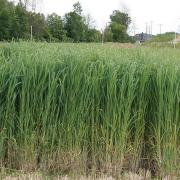A large increase of biofuel production is necessary to meet the Renewable Fuel Standard set in the 2007 Energy Independence and Security Act (EISA). This article explores the feedstock portfolio required to do the job.
|
|
| Switchgrass a source of biomass energy. Photo: Dennis Pennington, Bioenergy Educator, Michigan State University. |
Contents
- Energy Independence and Security Act
- Biomass Defined
- Biomass Resource Potential
- The Future of Biomass Feedstocks
Energy Independence and Security Act
The Energy Independence and Security Act (EISA) of 2007 was a milestone in U.S. energy policy. It solidified previous movements toward renewable energy by expanding the Renewable Fuels Standard (RFS) to 25 percent of the United States current petroleum consumption — 36 billion gallons of ethanol — by the year 2022. The RFS was expanded to include 15 billion gallon of ethanol from starch and sugar based feedstocks (corn, sugarcane), 16 billion gallons from cellulosic feedstocks (corn stover, switchgrass, woody plants) and 5 billion gallons from advanced biofuels (see Figure 1). The biggest challenge ahead lies in development of technology and discovery of new processes that will make the conversion of biomass to ethanol more efficient and profitable.
|
|
| Sugar cane a source of ethanol. Photo: Zane R. Helsel, Extension Specialist in Agricultural Energy, Rutgers University. |
Biomass Defined
Biomass is all parts of any type of plant, including the leaves and stems, not just the starch and sugars. All plant cells contain cellulose, hemicellulose and lignin in the cell walls. Cellulose and hemicellulose are made up of linear and branched chains of sugars. Plant cell walls can be broken down, the cellulose and hemicellulose exposed and then converted into basic sugars. The sugars can then be fermented into ethanol and other biobased products, similar to corn ethanol. Conversion rates for different processes and feedstocks vary tremendously. It is estimated that it will take 1 billion tons of biomass per year to produce 21 billion gallons of ethanol. While this goal seems lofty, it is quite realistic, although it will require a diverse portfolio of products.
Biomass Resource Potential
The U.S. Department of Energy (DOE) and the U.S. Department of Agriculture (USDA) commissioned a study to evaluate the potential volume of feedstock needed in order to meet the objectives of the FSA set forth in the EISA. The study evaluated a variety of issues surrounding biomass feedstocks, including long-term soil carbon and productivity, soil erosion, accessibility, transportation costs, nutrient runoff and feasibility of collection/transportation. Figure 1 shows the relative distribution of feedstock by resource. Notice that the total resource potential is well above the goal at almost 1.4 billion tons.
These resource potentials were divided into primary, secondary and tertiary categories according to volume and feasibility. Production of existing and new biomass feedstocks as well as improving yield will be an important part of achieving the RFS goals. Equally important is collection of waste and byproducts from processing of forest and agricultural products.
|
|
| Hybrid Poplar for biomass energy. Photo: Dennis Pennington, Bioenergy Educator, Michigan State University. |
The Future of Biomass Feedstocks
The DOE and the USDA are both strongly committed to expanding the role of biomass as an energy source. In particular, they support biomass fuels and products as a way to reduce the need for oil and gas imports; support the growth of agriculture, forestry, and rural economies; and foster major new domestic industries in the form of bio-refineries that manufacture a variety of fuels, chemicals and other products.
Forestland and cropland resources have the potential to provide in excess of 1.3 billion dry tons annually — the equivalent of more than one-third the current demand for transportation fuels. More than 25 percent of this potential would come from extensively managed forestlands and about 75 percent from intensively managed croplands. The major primary resources would be logging residues and fuel treatments from forestland and crop residues and perennial crops from agricultural land.
Contributors to This Article
Author
Peer Reviewers
- Cole Gustafson, Biofuels Economist, North Dakota State University
- Greg Roth, Penn State





